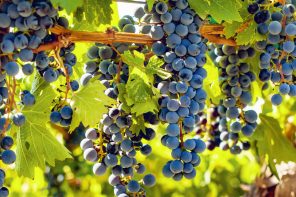I’ll have a glass of Cabernet. We’ve all uttered these words at least once in our lifetimes, expecting a serving of full-bodied, fruit-forward Cabernet Sauvignon to be placed at our fingertips. However, before Cabernet Sauvignon, there was (and still is) another Cabernet – a lighter, earthier, equally delicious yet entirely different specimen of grape.
Cabernet Franc, the “other” Cabernet, often gets cast in the shadows, living behind its bellowing, fuller-bodied counterpart. However, this grape has some serious history; in fact, it’s actually one of the parents to Cabernet Sauvignon. Cabernet Franc is much less heavy than Cabernet Sauvignon, producing brighter, lighter-bodied wines. The grape ripens earlier than Cabernet Sauvignon, allowing for successful growth in cooler climate regions. In Bordeaux, where the grape finds its origins, it is predominately used as a blending grape. Further north in the Loire Valley, Cabernet Franc – otherwise known as Breton in local dialect – is made into varietal wine. Grab a Chinon, Borgeuil or Saumur-Champigny to see this little beauty shine on its own. Common aromas and tasting notes include green bell pepper, raspberry and cassis. Closer to home, Cabernet Franc is used in ice wine production in the US and Canada.
One day, back in the 17th century in southwestern France, Sauvignon Blanc met Cabernet Franc and they had a baby named Cabernet Sauvignon. Little did they know this love child would become one of the most popular wine grapes in the entire world, growing in places from Australia to the Middle East. Cabernet Sauvignon is a small, thick-skinned grape, producing wines that are abundant with tannins and moderate acidity, allowing for maximum aging potential. The wines are full bodied and luscious, often with notes of dark fruit, olive, and cedar, depending on where the grape was grown.
In France, Cabernet Sauvignon is known as the backbone in many Bordeaux blends, specifically of the Left Bank. The Cab is generally blended with Merlot and Cabernet Franc, oftentimes with Petit Verdot and/or Malbec as well (this blend is known as Meritage in United States “Bordeaux blend” wines.) Cabernet Sauvignon is also a famed component of the Super Tuscan, a bold red wine from Italy consisting of combinations of Cab, Merlot and Sangiovese.
The warm, sunny climates of California are very conducive to growing Cabernet Sauvignon. The grapes here tend to get riper, producing fuller-bodied, fruit-forward style wines. Let us remember the Judgement of Paris in 1976, where Stag’s Leap Cabernet beat out Cabernet blends from the highest quality Chateaux in Bordeaux. Cabernet Sauvignons may undergo extended maceration and are fermented at high temperatures, extracting abundant phenols and tannins, leading to an even bigger final product. Oak generally plays a big role in the production of Cabernet Sauvignon, where the influence is used to soften tannins and add creamy, vanilla spice flavors to the wine.
Because of its full-bodied nature, Cabernet Sauvignon tends to be more “food wine” as opposed to Cabernet Franc, which can pair well with food or stand solidly on its own. The stronger tannins in Cabernet Sauvignon make it an ideal pairing for steaks, heavy cream-based sauces and even dark chocolate. Cabernet Franc pairs beautifully with grilled vegetables, poultry and lentils. Food or no food, warm weather or cold, there’s certainly a Cabernet for every situation.









Help celebrate Cab Franc on #CabFrancDay Dec. 4th!